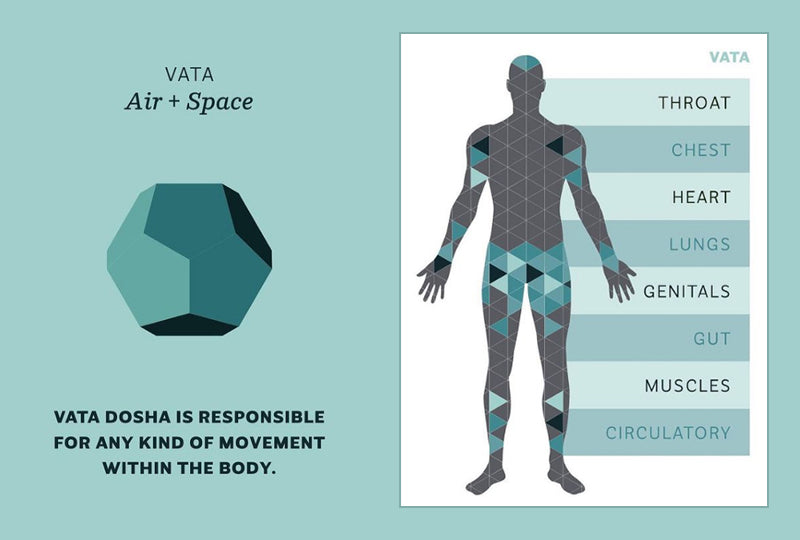
Vata Dosha is a combination of Air (Vayu) and Space (Aakash) elements. This dosha is responsible for any kind of movement that takes place within the body. These include our regular daily life routine actions to the subtle and dynamic movements that take place within the body.The presence of Vata helps us breathe, speak, move and excrete. Vata's movement assists the movement of breath, the flow of blood through the circulatory system, the movement of our vocal cords, the chewing of food, swallowing, and digesting of the same.
Vata Dosha, being a combination of the highly mobile and dynamic ‘Air’ and the emptiness of ‘Space’, is also associated with the nervous system. A chronic imbalance of Vata could lead to nervous system disorders like Alzheimer’s, Epilepsy, Parkinson's, and other such diseases. An imbalance of Vata also leads to variating blood pressure levels, urinary disorders, migraine, etc. Therefore, maintaining a balanced Vata within the body is very crucial.
Even though Vata and the other two doshas (Pitta and Kapha) are present throughout the body, they tend to congregate in certain areas. One of the prominent areas of operation for Vata is below the navel as it is responsible for the excretion of wastes, the outflow of menstrual blood, and also assists the process of giving birth.
There is one force of Vata that operates throughout the body. However, based on the different directions it runs in, Vata Dosha can be divided into five sub doshas:
- Prana Vata: It operates in the area between the diaphragm and the throat, and rules the functioning of the heart, lungs, brain, and esophagus. It also assists in the intake of food, water, and air, into our systems, and directing the other Vatas. It is the source of all life force energy.
- Udana Vata: This operates between the throat and the top of the head, and is responsible for speech, expression, memory, vitality, endeavor, and complexion.
- Samana Vata: Its area of operation is between the diaphragm and the navel. This Vata helps with digestion, assimilation of nutrients and helps other Vatas to stay in balance.
- Vyana Vata: This is present throughout the body, and primarily helps with blood circulation, lymph flow, movement of the body, and perspiration.
- Apana Vata: This operates between the navel and the anus, and is responsible for the excretion of wastes such as urine, gas, feces, and expelling of semen, menstrual blood, and fetus (during birth).
Imbalanced Vata
An imbalance of Vata results in gas, flatulence, migraine (a case where Vata shoots up into the brain), instability of mind, fatigue, jumpiness, spaciness in the head, or pain anywhere in the body. For example, Joint pain, pain in the calf muscles, toothache, migraine, or pain due to gas in the stomach is caused by an imbalanced Vata.
To soothe this jumpy dosha, it is good to indulge in calming somatic practices or creative activities that allow for the Vata to find a healthy rhythm. Practices such as meditation, light exercises, rhythmic breathing coordinated with movements such as Qi gong and Tai chi could be particularly helpful in balancing the Vata Dosha.
Workings Of Vata Dosha
Vata is particularly active from 2 am to 6 am and from 2 pm to 6 pm. The early morning time is ideal for getting rid of mental and physical waste and is also an ideal time to meditate. Waking up during these hours helps us to cleanse ourselves of all wastes, allowing us to remain active throughout the day, and follow a good routine. During the evening, one must eat their meal before the Vata time kicks in to allow the Vata to be actively involved in the digestion process.
Another prominent quality of Vata Dosha is dryness. Excess of Vata leads to the formation of dry skin and increases dryness inside the body. This leads to the deterioration of 'Dhatus', the bodily tissues. Excessive dryness also leads to constipation and the accumulation of toxins within the body.
Balancing Vata
Simple tips to help improve Vata balance within the body include :
- Herbs and spices such as Hing, Cumin Seeds (Jeera), Ajwain, Fennel, And Cardamom help soothe aggravated Vata.
- Eat freshly prepared and warm foods, particularly in the mornings and evenings to improve the digestion process. Include healthy and natural fats like ghee and butter in your food to help balance Vata and remove dryness.
- Have a cup of Vata balancing tea to promote relaxation. It also helps in relieving gas build-up and nausea and improves digestion.
- Going hungry for long periods can aggravate Vata, so try to stick to a healthy eating schedule.
- In case, your 'Prakriti' is Vata dominant, then movement-oriented activities naturally appeal to you. Therefore, choose an activity that helps you direct your energy creatively and productively.
- Avoid overexerting yourself. It tends to aggravate Vata.
At Butterfly Ayurveda, we offer a range of products to help keep the Vata in balance. Some of these include Prana Cookies, Shubh Saanjh Chai, Tulsi Green Tea, Ratri Chai, and Tummy love. We also encourage you to incorporate Ayurvedic wisdom in your daily lifestyle to improve the quality of your life.

Comments (0)
Back to Get Healthy with Akshi